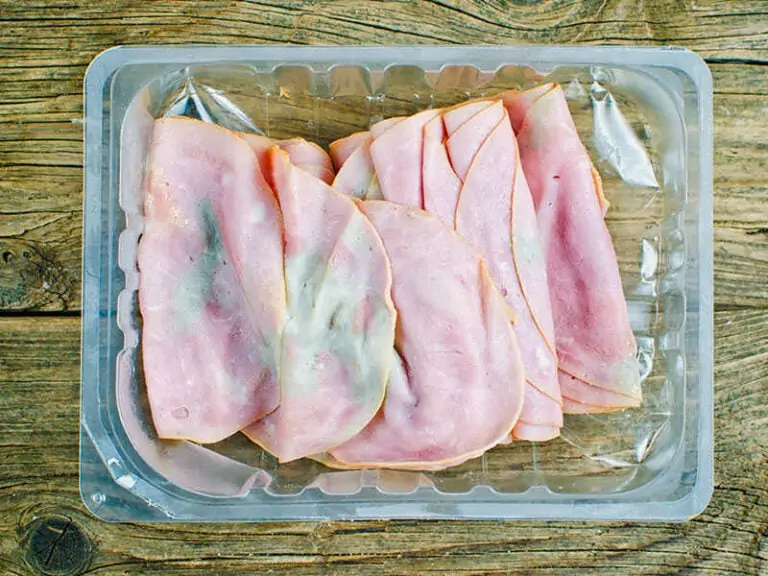As a lover of holiday ham nothing dampens my Christmas spirit quite like slicing into a beautifully glazed ham only to find an unappetizing grayish color lurking beneath the surface. If you’ve also wondered “why did my ham turn gray?” you’re not alone. Many cooks have scratched their heads over this puzzling phenomenon. Let’s get to the bottom of this culinary mystery and explore what causes ham to go gray.
The Science Behind Grey Ham
It turns out there are a few key scientific reasons why properly pink ham can take on a dull, grayish cast during cooking.
Oxidation
Just like how an apple left out on the counter eventually turns brown, ham will also oxidize and change color over time Exposure to light and oxygen causes oxidation reactions to take place in the meat proteins and pigments. This oxidation breaks down the pink color molecules formed during curing
Denaturing Proteins
When ham is cooked at high temperatures for too long, the heat causes the proteins in the meat to denature. This protein change destroys their structure, causing them to unravel and lose their ability to hold onto pink pigments. The denatured proteins reflect light differently, resulting in a gray appearance.
Microbial Spoilage
Bacteria, mold and yeasts present on ham can also contribute to graying through their metabolic processes. These microbes break down and consume compounds like heme proteins responsible for ham’s rosy color. Their waste products cause the dull, gray discoloration.
Loss of Nitrites
Curing salt containing nitrites gives ham its iconic pink hue. However, over time and with heat, nitrites can break down into nitric oxide and dissipate. This loss of nitrites allows the natural gray color of uncooked pork to show through.
Tips to Avoid Gray Ham
Luckily, there are some simple tips you can follow to prevent gray ham and keep it pink:
-
Use fresh, high-quality ham and store properly before cooking.
-
Thaw frozen ham thoroughly in the fridge before cooking.
-
Cook ham at lower temperatures like 325°F to avoid protein denaturing.
-
Don’t overcook; use a meat thermometer and stop when it reaches 145°F.
-
Add antioxidants like vitamin E or rosemary extract to the curing brine.
-
Store any leftover ham properly wrapped in the fridge to prevent oxidation.
-
Glaze or coat the ham in mustard to protect from oxygen.
-
Slice only what you plan to eat to minimize air exposure.
Can You Still Eat Gray Ham?
The good news is that while unappetizing in color, gray ham caused by overcooking or oxidation is still perfectly safe to eat. The proteins have merely changed shape, not composition.
However, if the gray color is accompanied by an off smell, sticky texture, or any mold, it’s best to discard the ham. These signs indicate more significant spoilage that can cause illness.
But if it’s just the visual discoloration from cooking, the gray ham can be chopped up and used to make ham salad, soups, scrambled eggs or in any recipe where appearance isn’t as important.
While you may prefer to avoid serving it cold cuts, spending time making a glaze and cooking a ham only to end up with gray meat is disappointing. Following the tips above will help ensure your holiday ham stays a festive pink from start to finish!
Frequently Asked Questions About Gray Ham
Why did my cooked ham turn gray overnight?
Leaving cooked ham sitting out allows oxidation and microbial growth to occur, causing the color change. Always store cooked ham properly wrapped in the fridge.
Can I reuse gray ham broth?
Yes, the broth is still safe to consume or reuse for soup bases, beans, etc. The gray color is only cosmetic and does not make it unsafe.
What causes a white film on ham?
A white film is usually coagulated protein and fat. It can form if ham is stored at too high a temperature or cooked in liquid that is too alkaline. It doesn’t affect safety.
Should I remove ham fat before cooking to prevent graying?
No, keeping the fat on provides protection from oxygen and evaporation during cooking. Trim only after cooking if desired.

What Is the Rainbow Sheen on Ham?
You may have noticed a glistening, sometimes greenish, rainbow iridescent effect on cut ham. This is not necessarily an indication of spoilage. When hams that were cured with nitrates and/or nitrites are exposed to light and air, the color changes because of a chemical reaction. These same nitrates are the cause of the meat color remaining rosy red, even when fully cooked.
